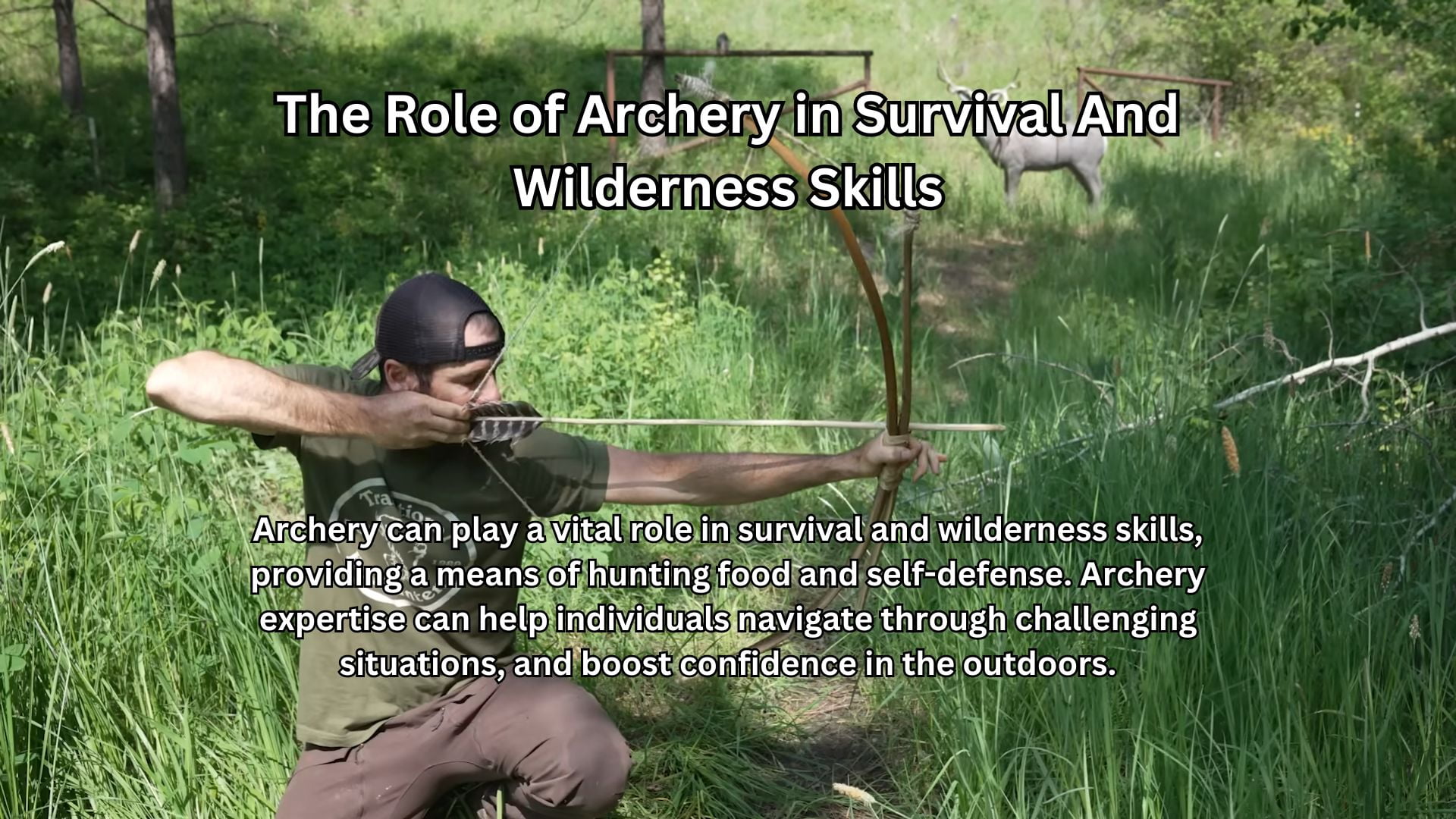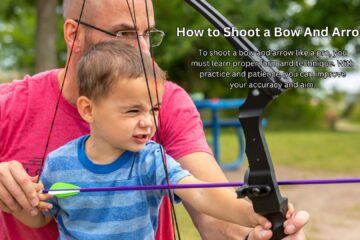Archery can play a vital role in survival and wilderness skills, providing a means of hunting food and self-defense. Archery expertise can help individuals navigate through challenging situations, and boost confidence in the outdoors.
It is an ancient skill that dates back over 10,000 years, originally used for hunting and warfare. It is still a relevant skill in modern times, especially for those who enjoy outdoor activities such as camping, hiking, and survivalism. Archery can be beneficial in wilderness survival situations, providing a means of hunting food and self-defense.
It requires discipline, practice, and patience, all of which are valuable traits to have in the outdoors. In addition to practical applications, archery is also a great stress-relieving activity that can help individuals stay calm and focused in challenging situations. In this article, we will explore the role of archery in survival and wilderness skills and its practical applications.
The Benefits Of Archery In Survival Situations
Archery has been an essential skill in human survival for thousands of years. Whether it’s for hunting, self-defense, or just for fun, archery has a significant role in our lives. But did you know that archery can also help in survival situations?
In this blog post, we will discuss the benefits of archery in survival situations.
The Mental And Physical Benefits Of Archery
Archery is beneficial for both the mind and body. Here are some of the physical and mental benefits of archery:
- Physical benefits:
- Improved balance and coordination
- Increased upper body strength
- Enhances hand-eye coordination
- Provides a low-impact form of exercise
- Mental benefits:
- Increases focus and concentration
- Helps reduce stress and anxiety
- Promotes mindfulness
- Improves memory retention
How Archery Can Help With Stress And Anxiety In Survival Situations
Stress and anxiety are common in survival situations. Archery can help manage these concerns as it requires a certain level of concentration and mindfulness. Here are some ways archery can help with stress and anxiety:
- A sense of control: Archery requires a certain level of control, which provides comfort in times of unpredictability.
- Focus and concentration: Archery requires focus and concentration. It can help you in controlling your thoughts and distraction. It is similar to meditation, which can help in calming the mind.
- A sense of accomplishment: Archery can be a challenging skill to master. But once you’ve done it, you will feel a sense of accomplishment that helps to soothe anxiety and stress.
The Importance Of Precision And Focus In Archery
Archery is a sport that requires precision and focus. When it comes to survival, having these skills are vital. Here are some reasons why precision and focus are essential in archery:
- Accurate aiming: When hunting or protecting yourself, aiming, and precision is crucial. Archery trains you to aim for a particular target, so you know exactly where you are supposed to hit.
- Efficiency: To hit the bullseye, you need to be precise. In survival situations, archery can help you to make efficient use of your resources. It helps you to choose the right path to aim and achieve the desired outcome.
- Adaptability: Archery is a skill that requires adaptability. It prepares you for the unexpected, so, if the emergency occurs, your mind will be ready to respond accurately and efficiently.
Archery has a significant role in survival situations. It can help improve physical fitness and mental health, manage stress and anxiety, and enhance precision and focus. Whether for sport or survival, archery can provide a full range of benefits, and learning this skill can be an excellent investment for anyone who wants to improve their chances of survival.
Basic Archery Techniques For Survival
Archery is one of the oldest and most versatile forms of hunting, as well as an effective survival skill for the wilderness. Whether you are a beginner or an experienced archer, it is important to understand the basic techniques required for survival.
In this section, we’ll explore the essential equipment and techniques for archery in survival situations.
Essential Equipment For Archery In Survival Situations
Before going on a hunting trip, it’s essential to equip yourself with the right tools. Here are a few essentials to keep in mind:
- Bow and arrows: When it comes to choosing a bow, it all comes down to personal preference. However, for survival purposes, consider investing in a recurve or longbow, which can be easily repaired in the field. As for arrows, we recommend carrying at least six in your quiver, each with a different head type, such as broadheads and field points.
- Finger tab or glove: Protect your fingers from calluses by using a finger tab or glove. These can also help improve your grip on the bowstring.
- Armguard: An arm guard can protect your forearm from the bowstring, which can leave a welt or even cause serious injury.
How To Properly Handle A Bow And Arrow
Knowing how to handle your bow and arrow is crucial for both safety and accuracy. Here are a few key tips to remember:
- Always point the bow in a safe direction, away from other people and animals.
- Use the correct stance by planting your feet shoulder-width apart with your toes pointed perpendicular to the target.
- Grip the bow with your non-dominant hand, making sure to keep your wrist straight.
- Hold the bowstring with your dominant hand, using your fingers and a finger tab or glove, while keeping your elbow up and parallel to your shoulder.
Basic Shooting Techniques For Beginners
Now that you know how to hold your bow and arrow, it’s time to start learning how to shoot properly. Follow these steps to get started:
- Nock the arrow onto the bowstring.
- Draw the bowstring back by extending your arm towards the target while keeping your elbow up.
- Aim at the target by aligning the bow and arrow with your eye and focusing on the target.
- Release the arrow smoothly, without jerking or twisting your hand.
Fixing Common Mistakes In Shooting
Even the most experienced archers sometimes struggle with accuracy. Here are a few common mistakes to watch out for and how to fix them:
- Anticipating the shot: Some archers may flinch or move before releasing the arrow, causing the arrow to veer off course. To avoid this, calmly focus on the target and let the arrow go.
- Gripping the bow too tightly: A common mistake for beginners, gripping the bow too tightly can cause the bow to torque and affect accuracy. Try loosening your grip slightly and using your non-dominant hand to balance the bow.
- Improper alignment: Make sure your elbow is up and aligned with your shoulder to ensure accuracy. Your wrist should also be straight, and your shoulders should be relaxed and level.
With these basic archery techniques for survival in mind, you’ll be well on your way to mastering this essential survival skill. Remember to practice regularly and be safe while enjoying the great outdoors.
Advanced Archery Techniques For Survival
Archery is a skill that can prove invaluable in a survival situation. The ability to hunt effectively and protect oneself from danger can make the difference between life and death. However, basic archery skills are not always enough for the challenges that come with surviving in the wilderness.
Advanced archery techniques can boost your survival odds and improve your hunting game. Here are some helpful tips for mastering archery accuracy, shooting effectively in different terrains and weather, and constructing a bow and arrow from natural resources.
Mastering Archery Accuracy For Hunting Game
Hunting game requires precision and accuracy. Here are some tips for mastering archery accuracy to help improve your hunting skills.
- Practice your shooting form: Proper form is essential for good accuracy. Ensure your feet are shoulder-width apart, and your back is straight.
- Understanding arrow trajectory: It’s important to know how an arrow flies over a distance. Take the time to learn the trajectory of your arrows by practicing at different distances.
- Improve your breathing: It’s challenging to shoot accurately when your breathing is erratic. Practice deep breathing to help improve your aim.
How To Shoot Effectively In Different Types Of Terrain And Weather
Weather conditions and terrain can affect your archery skills. Here are some tips for shooting effectively in different situations.
- Accounting for wind: Wind can affect your arrows’ trajectory, making it hard to shoot accurately. Adjust your aim for the wind direction and speed.
- Shooting at an angle: Shooting uphill or downhill can alter your aim. Practice shooting at different angles to get a feel for how your arrows fly.
- Shooting in the rain: Rain can make it hard to grip your bow and arrows. Keep a dry towel handy to wipe down your equipment, and use a waterproof cover for your bow.
How To Construct A Bow And Arrow From Natural Resources
In survival situations, you may not have access to your store-bought bow and arrows. Here are some tips for constructing a functional bow and arrow from natural resources.
- Choosing the right wood: Select a durable type of wood for your bow, such as cedar, hickory, or yew. Look for one that is straight and flexible.
- Making the bowstring: Use natural fibers from plants like dogbane, yucca, or nettle to make the bowstring.
- Crafting arrowheads: Use sharp rocks or bones to create arrowheads. Make sure the arrowhead is secure and won’t come off when fired.
By mastering these advanced archery techniques, you will be better equipped to handle the challenges of survival in the wilderness. Remember to practice frequently and hone your skills. With the right preparation, you can improve your hunting game and increase your chances of surviving in the wild.
Archery In Wilderness Navigation
Navigating through dense forests, mountains, and wild terrain can be challenging, but archery can play a significant role in wilderness navigation. Here are some tips on how to use archery tools to make your wilderness navigation easier:
How To Use Archery Tools For Wilderness Navigation
- Archery tools like bows and arrows and atlatls can be used as directional guides to point you in the right direction. The key is to find a familiar landmark to use as a reference point and aim for it.
- Use a sighting compass to determine the direction to your destination and adjust your aim accordingly.
- Use a bow and arrow or atlatl to launch arrows with strips of cloth to mark your trail. This method is particularly useful if you need to backtrack your way or if visibility is low.
- Use your bow as an extended measuring tool. By holding your bow horizontally, you can measure out distances more accurately.
Using Archery To Mark Trails And Locate Campsites
- Create a trail marking system using colored flagging tape and use archery to launch arrows with strips of these colorful ribbons tied to them to mark your trail.
- Set up target shooting stations to reduce the risk of accidents for your fellow campers.
- Archery tools can be used to help locate campsites, especially in dense forests. Shoot arrows or atlatl darts with colored ribbons attached to them to mark the location of your campsite.
The Role Of Archery In Orienteering And Map Reading
- Archery can play an essential role in orienteering when you don’t have access to a compass or map. By using a simple string compass to determine north and opting for a longbow instead of a more traditional compass can help you navigate through wilderness areas.
- Use the direction of the sun and shadows cast by trees to determine direction and adjust your aim accordingly.
- Use your bow as a straight edge to draw lines on your map and accurately pinpoint your location.
Archery can be a powerful tool in wilderness navigation. By using bows and arrows and atlatls, archers can find their way through unfamiliar terrain, mark their trails, and locate their campsites. By taking advantage of its versatility, archery can be a valuable asset to outdoor enthusiasts looking to improve their survival and wilderness skills.
Archery For Self-Defense In Survival Situations
When it comes to wilderness and survival situations, having the necessary skills to protect oneself is crucial. Archery is one discipline that can be used for self-defense in such situations. In this post, we will examine essential self-defense techniques using archery, as well as the legalities of using it for self-defense.
How Archery Can Be Used For Self-Defense In Wilderness And Survival Situations
Archery has been used for hunting and warfare for thousands of years and remains relevant for self-defense in wilderness and survival situations. The following are ways archery can be used for self-defense:
- Archery provides distance: Using a bow and arrow allows you to keep your distance from predators or attackers, keeping them at bay while providing time to evaluate the situation and plan your next move.
- Higher accuracy than a gun: In close quarters, a bow is easier to use than a gun since you don’t need to aim carefully. Additionally, bow hunting typically requires mental and physical acuity, so the user is less likely to miss their target.
- Silent hunting: Arrows are quieter than guns, so you can take your shot without alerting nearby predators or attackers.
Essential Self-Defense Archery Techniques
There are several techniques that you should master to have successful and effective self-defense when using archery. Understanding these techniques will help you survive in the wilderness. These include:
- Practice: Practice is essential in archery, especially if used for self-defense.
- Master your form: Having proper form helps you aim and shoot accurately, reducing misses, and giving you an advantage.
- Aim for high-impact spots: If you’re defending yourself, aim for vital organs or vulnerable spots, such as the head or neck.
- Train in situational awareness: Train yourself to be aware of your surroundings and to anticipate incoming threats continually.
- Use small arrowheads: Small arrowheads will make your arrow penetrate more effectively, and will reduce the possibility of the arrow getting stuck in its target.
The Legal Implications Of Using Archery For Self-Defense
When using archery for self-defense in a survival situation, it’s vital to understand the legal implications. Here are some points to note:
- Using archery for self-defense might be lawful: Depending on your location, laws regarding the use of archery for self-defense in survival situations might vary. Study these laws and consider taking courses in archery safety and self-defense to avoid legal implications.
- Using unjustified force can lead to consequences: It’s unethical and illegal to use archery to hurt someone without justification. If you’re defending yourself, you must make sure that you’re legally in the right.
- Notify authorities: Injuries resulting from self-defense using archery must be addressed promptly. Contacting the authorities can help give guidance on next steps to take, such as getting medical aid and filing a police report.
Mastering archery for self-defense takes patience and a lot of practice, and understanding the legal implications is crucial. By practicing proper archery techniques and situational awareness, you’ll be ready to handle any situation that comes your way. Remember; never use disproportionate force, and always stay within the boundaries of the law.
Frequently Asked Questions Of The Role Of Archery In Survival And Wilderness Skills
What Is Archery And Its Use In Survival And Wilderness Skills?
Archery involves using a bow to shoot arrows at a target. In survival and wilderness skills, archery can be used for hunting, fishing, and protection. It is a useful skill to have, as it helps you to remain self-sufficient when in the wilderness.
What Are The Benefits Of Learning Archery In Survival And Wilderness Skills?
Archery in survival and wilderness skills provides a range of benefits, including being able to catch food and protect oneself from danger. Learning archery also teaches patience, focus, and precision, which can be useful not only in survival skills but also in day-to-day life.
Is Archery A Difficult Skill To Learn For Survival And Wilderness Skills?
Like any skill, archery takes time and practice to master. However, it is not overly difficult to learn. By focusing on safety and the basics such as proper stance and technique, beginners can quickly progress in their archery skills.
What Type Of Bows Are Commonly Used In Survival And Wilderness Archery?
There are several types of bows used in survival and wilderness archery, including longbows, recurve bows and compound bows. Each has its own advantages and disadvantages. It is important to choose a bow that suits your skill level, budget and specific needs.
Can Archery Be Dangerous In A Survival Or Wilderness Situation?
Archery can be dangerous if not done correctly. It is important to always observe safety rules, such as ensuring that no one is in front of or behind the target, using the correct arrows, and not pointing the bow at anyone.
With proper safety measures, archery can be enjoyed safely in survival and wilderness situations.
Conclusion
As we conclude this discussion, it’s evident that archery is not just a sport but a valuable skill for survival and wilderness. Mastery of archery not only enhances one’s physical and mental coordination, but it also instills patience, focus, and discipline.
This is particularly essential in a survival situation where quick and accurate decision making is crucial. The ability to hunt for food and protect oneself from dangerous wildlife is key in the wilderness, and archery provides a practical solution. Additionally, practicing archery builds confidence, which is necessary for any survival situation.
By mastering archery, one can achieve self-reliance and the ability to survive in the most primitive environments. Therefore, we should embrace and celebrate the significance of archery in society, not only as a sport but as a valuable skill that can save lives in challenging situations.







